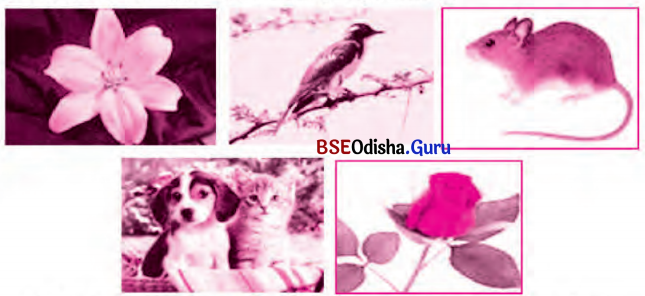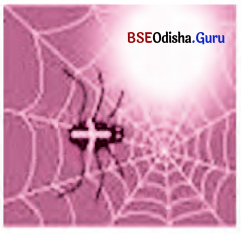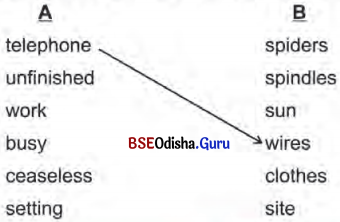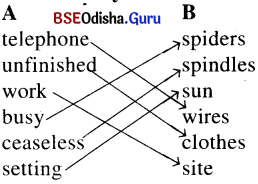Odisha State Board BSE Odisha 7th Class English Solutions Lesson 7 Cobwebs Textbook Exercise Questions and Answers.
Class 7th English Chapter 7 Cobwebs Question Answers BSE Odisha
Cobwebs Class 7 Questions and Answers
Session – 1
I. Pre-Reading
- Socialization (ସାମାଜିକୀକରଣ) :
- Look at the following pictures, ( ନିମ୍ନ ଚିତ୍ରଗୁଡ଼ିକୁ ଧାନର ସହିତ ଲକ୍ଷ୍ୟକର ।)
- Are they very common? ( ସେଗୁଡ଼ିକ ଅତି ସାଧାରଣ କି’ ?)
Ans. Yes, they are vey common bee in flower, mouse, a bird, a dog and a cat, branch of a flower tree etc.

Is it possible to write poems on such common topics like dog, cat, mouse, rose, cuckoo, etc?
(ସାଧାରଣ ବିଷୟକୁ ନେଇ ଯଥା- କୁକୁର, ବିଲେଇ, ମୂଷା, ଗୋଲାପ, କୋଇଲି ଉପରେ କବିତା ଲେଖିବା ସମ୍ଭବ କି ? )
Answer:
Yes, it is possible to write poems on such common topics like dog, cat, mouse, rose, cuckoo etc. Poets have written many poems on these and many other very common themes.
(କବିମାନେ ଅନେକ କବିତା ଏଗୁଡ଼ିକ ଉପରେ ତଥା ଅନ୍ୟ ସାଧାରଣ ବିଷୟକୁ ନେଇ ଲେଖୁ ସାରିଛନ୍ତି ।)
See The other picture below. What is this picture? Can you guess the topic of this poem?
(ନିମ୍ନସ୍ଥ ଛବିଟିକୁ ଦେଖ । ଛବିଟି କ’ଣ ? ତୁମେ କ’ଣ ଏହି କବିତାର ବିଷୟବସ୍ତୁକୁ ଅନୁମାନ କରିପାରୁଛ ? )
Answer:
This is a picture of a spider. The topic of this poem is possibly the skill of a spider.
Isn’t it also a very common sight?
(ଏହା ମଧ୍ୟ ଏକ ସାଧାରଣ ଦୃଶ୍ୟ ନୁହେଁ କି ?)
Answer:
Yes, it is a common sight that a spider weaves a cobweb to catch its prey (ଶିକାର)
Let’s read this poem and see how poets write poems on these common themes.
(ଚାଲ ଏହି କବିତାଟିକୁ ପଢ଼ିବା ଏବଂ ଦେଖିବା କବିମାନେ କିପରି ସାଧାରଣ ବିଷୟବସ୍ତୁକୁ ନେଇ କବିତା ଲେଖନ୍ତି ।)
![]()
II. While-Reading
Read the poem silently and answer the questions that follow.
(କବିତାଟିକୁ ନୀରବରେ ପାଠ କର ଏବଂ ନିମ୍ନ ପ୍ରଶ୍ନଗୁଡିକର ଉତ୍ତର ଦିଅ ।)

The long stretch of cobwebs
on telephone wires
look white
like the weaver’s unfinished clothes
at the work site.
The busy spiders
with their ceaseless spindles
Weave day and night.
The selling sun
pours into them
colours or rainbow bright.

But the moon
turns theni
into magic white
The long stretch of cobwebs “‘r
on telephone wires
look white
like the weaver’s unimnished clothes
at the work site.
ଓଡ଼ିଆ ଅନୁବାଦ :
ଲମ୍ବ ବିସ୍ତାରିତ ସେହି ବୁଢ଼ୀଆଣୀ ଜାଲ
ଦୂରଭାସ ଯନ୍ତ୍ର ତାର ଉପରେ
ଦିଶଇ ଧବଳ
ଯେପରିକି ତନ୍ତୀର ସେ ଅସମାପ୍ତ ବସ୍ତ୍ର
ଲାଖୁଥାଏ କମ କ୍ଷେତ୍ରେ ତା’ର
ବ୍ୟସ୍ତ | କାର୍ଯ୍ୟରତ ବୁଢ଼ିଆଣୀ ସବୁ
ଅବରତ ସହିତ ଉପରେ
ବୁଣୁଥା’ନ୍ତି (ବସ୍ତ୍ର) ଦିବା ଆଉ ରାତ୍ର ।
ଅସ୍ତଗ।ମା ସୂର୍ୟ୍ୟ
ଢାଳେ ତା’ ଉପରେ
ଇନ୍ଦ୍ରଧନୁର ରଙ୍ଗିନ ଉଜ୍ଜ୍ବଳ ଆଲୋକ
କିନ୍ତୁ ଜହ୍ନ ଯେବେ ତା’ ଉପରେ
ଭରିଦିଏ ଶୁଭ୍ରତା ଭାସେ ଜାଦୁର ।
ଲମ୍ବ ବିସ୍ତାରିତ ସେହି ବୁଢ଼ିଆଣୀ ଜାଲ
ଦୂରଭାସ ଯନ୍ତ୍ର ତାର ଉପରେ
ଦିଶଇ ଧବଳ
ଯେପରିକି ତନ୍ତୀର ସେ ଅସମାପ୍ତ ବସ୍ତ୍ର
ଲାଖୁଥାଏ କର୍ମକ୍ଷେତ୍ରେ ତା’ର ।
Notes And Glossary
stretch (ଷ୍ଟେଟ୍) – ବିସ୍ତାରିତ
cobweb (କବ୍) – ବୁଢ଼ୀଆଣୀ ଜାଲ
spider (ସ୍ପାଇଡ଼ର୍) – ବୁଢ଼ୀଆଣୀ
weaver (ଓଭର) – ବୁଣୀଲ।
wires (ଓୟାରସ୍) – ତାର ସବୁ
ceaseless (ସିସ୍) – ନିରନ୍ତର
spindles (ସିଣ୍ଡଲ୍ସ୍) – ତାକୁଡ଼
rainbow (ରେନ୍ବୋ) – ଇନ୍ଦ୍ରଧନୁ
![]()
- Your teacher reads the poem aloud and you listen to him/her.
( ତମ ଶିକ୍ଷକ କବିତାଟିକ ଉଚ୍ଚସ୍ତରରେ ପଢ଼ିବେ ଏବଂ ତୁମେ ତାଙ୍କୁ ଶୁଣବ ।) - Your teacher reads the poem aloud, you listen to him/her and at the same time see the text.
(ତୁମ ଶିକ୍ଷକ କବିତାଟିକୁ ଉଚ୍ଚସ୍ବରରେ ପାଠ କରିବେ ଏବଂ ତୁମେ ସେହି ସମୟ ତାଙ୍କ ଶଣିବା ସହିତ ପାଠ୍ୟପୁସ୍ତକ ଦେଖୁବ ।) - You read the poem silently.
( ତମେ କବିତାଟିକ ନୀରବରେ ପାଠ କର ।)
Comprehension Questions
Question 1.
What is the poem about?
( କବିତାଟି କେଉଁ ବିଷୟରେ ? )
Answer:
The poem is about the cobwebs.
Question 2.
Where is the cobweb?
(ବୁଢ଼ିଆଣୀ ଜାଲଟି କେଉଁଠି ଅଛି ? )
Answer:
The cobweb is on telephone wires.
Question 3.
Is it in small pieces or in very long pieces?
(ଏହା କ’ଣ ଛୋଟ ନା ଖୁବ୍ ଲମ୍ବ ଖଣ୍ଡ ?)
Answer:
The cobweb is in very long pieces.
Question 4.
Which words tell you so?
(କେଉଁ ଶବ୍ଦପୁଞ୍ଜ ତୁମକୁ ଏହା କହୁଛି ?)
Answer:
The phrase “the long stretch of cobwebs” tells us so.
Question 5.
What is the colour of the cobweb on telephone wires?
( ଦୂରଭାସ ( ଟେଲିଫୋନ୍) ତାର ଉପରେ ଥିବା ବୁଢ଼ିଆଣୀ ଜାଲର ରଙ୍ଗ କିପରି ?)
Answer:
The colour of the cobweb on the telephone wires is white.
![]()
Question 6.
The long stretch of cobweb is like a?
(ଲମ୍ବ ବିସ୍ତାରିତ ବୁଢ଼ିଆଣୀ ଜାଲ ଭଳି ।)
Answer:
The long stretch of cobweb is like the weaver’s unfinished clothes.
Question 7.
Where is the unfinished cloth ? Who weaves the cloth?
(ଅସମାପ୍ତ ବୁଣା ବସ୍ତ୍ର କେଉଁଠି ଅଛି ? କିଏ ବସ୍ତ୍ର ବୁଣେ ?)
Answer:
The unfinished clothe is at the worksite. The weaver weaves the cloth.
Question 8.
Why are the spiders busy?
(ବୁଢ଼ିଆଣୀମାନେ ବ୍ୟସ୍ତ ଅଛନ୍ତି କାହିଁକି ?)
Answer:
The spiders are busy weaving the cobwebs day and night with their ceaseless spindles.
Question 9.
What is the meaning of ‘spindle’? Have you seen a spindle? Who uses the spindle? (See the word note)
(‘ତାକୁଡ଼ି’ର ଅର୍ଥ କ’ଣ ? ତୁମେ କ’ଣ ତାକୁଡି ଦେଖୁଛ ? କିଏ ତାକୁଡି ବ୍ୟବହାର କରେ ?)
Answer:
A spindle means a thin rod for the winding thread. Yes, I have seen a spindle. The weaver uses the spindle.
Question 10.
The spiders are compared to weavers. How are they alike?
(ବୁଢ଼ିଆଣୀମାନଙ୍କୁ ବୁଣାଳିମାନଙ୍କ ସହ ତୁଳନା କରାଯାଇଛି । ସେମାନେ କିଭଳି ଏକାଭଳି ?)
Answer:
The spiders weave the web and the weavers weave the clothes. So they are alike.
Question 11.
Who changes the white colour of the cobweb?
( କିଏ ବୁଢ଼ିଆଣୀ ଜାଲର ଶୁଭରଙ୍ଗକୁ ବଦଳାଇ ଦିଏ ?)
Answer:
The setting sun changes the white colour of the cobweb.
Question 12.
How many colours are there in a rainbow?
( ଇନ୍ଦ୍ରଧନୁରେ କେତୋଟି ରଙ୍ଗ ଥାଏ ? )
Answer:
There are seven colours in a rainbow.
![]()
Question 13.
When does the sun look better – at sunrise, at noon or at sunset?
(ସୂର୍ୟ୍ୟ କେତେବେଳେ ଅଧିକ ଭଲ (ସୁନ୍ଦର) ଦେଖାଯାଏ-ସୂର୍ଯ୍ୟୋଦୟବେଳେ, ମଧ୍ୟାହ୍ନରେ କିମ୍ବା ସୂର୍ଯ୍ୟାସ୍ତବେଳେ ? )
Answer:
The sun looks better at sunset.
Question 14.
How is the setting sun’s colour similar to that of a rainbow?
( ଅସ୍ତଗାମୀ ସୂର୍ଯ୍ୟର ରଙ୍ଗ ଇନ୍ଦ୍ରଧନୁର ରଙ୍ଗତୁଲ୍ୟ କିପରି ?)
Answer:
The setting sun’s beam is full of colours like the colours of a rainbow. So the setting sun’s colour is similar to that of a rainbow.
Question 15.
The white colour of the cobwebs ¡s changed into that of many coloured rainbows. Who changes this colour into white?
(ବୁଢ଼ିଆଣୀ ଜାଲର ଶୁଭ୍ରରଙ୍ଗ ଇନ୍ଦ୍ରଧନୁର ବିବିଧ ରଙ୍ଗ ଭଳି ବଦଳିଯାଏ । କିଏ ତାହାକୁ ଶୁଭ୍ର । ଧଳା ରଙ୍ଗରେ ବଦଳାଇଦିଏ ? )
Answer:
The moon changes the rainbow-coloured cobweb into white.
Question 16.
To start with, the colour of the cobweb in the poem was white. The setting sun changed it to the colour of a rainbow. The moon changed it white again. Are the white colours at the beginning and at the end similar or different? Which word tells you that there is a difference?
(କବିତାରେ ଆରମ୍ଭରୁ ବୁଢ଼ିଆଣୀ ଜାଲର ରଙ୍ଗ ଧଳା | ଶୁଭ୍ର ଥିଲା । ଅସ୍ତଗାମୀ ସୂର୍ଯ୍ୟ ତାହାକୁ ଇନ୍ଦ୍ରଧନୁର ରଙ୍ଗରେ ରଞ୍ଜିତ କଲେ । ଚନ୍ଦ୍ର ପୁନର୍ବାର ଏହାକୁ ଶୁଭ୍ର ଧଳା କରିଦେଲା । ଆରମ୍ଭ ଏବଂ ଶେଷର ବର୍ଣ୍ଣିତ ଧଳାରଙ୍ଗ ଏକାଭଳି ନା ଭିନ୍ନ ? ଏଥରେ ପାର୍ଥକ୍ୟ ଅଛି ବୋଲି କେଉଁ ଶବ୍ଦ କହୁଛି ? )
Answer:
The white colour of the cobweb at the beginning and at the end is different. Because at night the moon changes the colour of còbweb into magic white.
Question 17.
Which white colour is better – the first one or the second one
(କେଉଁ ଶୁଭ୍ର ରଙ୍ଗ ଅଧିକ ଭଲ – ପ୍ରଥମଟି ନା ଦ୍ଵିତୀୟଟି ? )
Answer:
The second white colour is better.
Question 18.
Do you like the poem?
(ତୁମେ କ’ଣ କବିତାଟିକୁ ପସନ୍ଦ କର ?)
Answer:
Yes, we like the poem.
Question 19.
Do you see how the common sight has been made uncommon by the poet? How the poets make beautiful poems out of very common topics will be discussed later.
(ତୁମେ କ’ଣ ଜାଣିପାରୁଛ ଯେ ସାଧାରଣ ଦୃଶ୍ୟ କବିଙ୍କ ଲେଖନୀରେ କିପରି ଅସାଧାରଣରେ ବଦଳିଯାଏ ? କବି କିପରି ଖୁବ୍ ସାଧାରଣ ବିଷୟରୁ ସଂଗ୍ରହ କରି ସୁନ୍ଦର କବିତା ଲେଖୁପାରନ୍ତି, ତାହା ପରବର୍ତ୍ତୀ ପର୍ଯ୍ୟାୟରେ ଆଲୋଚିତ ହୋଇଛି ।)
Answer:
Yes, we see that the common sight has been made uncommon by the poet.
![]()
Question 20.
In some poems, some stanzas are repeated. What are these stanzas called in Odia poems? (GHOSA) In English? (Refrain) Can you identify the refrain in this poem?
(କେତେକ କବିତାରେ କେତେଗୁଡିଏ ପଦ|ପଂକ୍ତିକୁ ଦୋହରା ଯାଇଥାଏ । ସେହି ପଦ ବା ପଂକ୍ତିକୁ ଓଡ଼ିଆ କବିତାରେ କ’ଣ କହନ୍ତି ? (ଘୋଷା) ଇଂରାଜୀ କବିତାରେ ? (ରିଫ୍ରେନ୍) ତୁମେ ଏହି କବିତାରେ ରିଫେନ (ଘୋଷା)କ ଚିହ୍ନଟ କରିପାରିବ କି ?)
Answer:
Yes, we can identify the refrain in this poem. The last stanza of this poem is a refrain.
Question 21.
Is this poem an old or a new one? Read lines one and two. Can you answer now? Have you seen telephone wires? Do we have telephone wires or towers nowadays? Guess how.
(ଏ କବିତାଟି ନୂତନ ବା ପୁରାତନ ? ପ୍ରଥମ ଏବଂ ଦ୍ବିତୀୟ ଧାଡ଼ିକୁ ପଢ଼ । ବର୍ତ୍ତମାନ ଉତ୍ତର ଦେଇପାରିକ କି ? ତୁମେ ଦୂରଭାସ | ଟେଲିଫୋନ୍ ତାର ଦେଖୁଛ ? ଆମେ ଆଜିକାଲି ଟେଲିଫୋନ୍ ତାର ରଖ୍ ନା ଟାୱାର ?)
Answer:
This poem is an old poem. Because nowadays we do not have telephone wires, but we have towers.
Question 22.
Poets give life to lifeless objects. They often treat non-living objects as living objects – living or even animals or insects as human beings. Do you find such examples in this poem? The spider is like a weaver. What about the sun and the moon?
(କବିମାନେ ନିର୍ଜୀବକୁ ସଜୀବ କରିପାରନ୍ତି । ସେମାନେ ଏପରିକି ନିର୍ଜୀବ ବସ୍ତୁକୁ ସଜୀବ ଦୃଷ୍ଟିରେ ଦେଖନ୍ତି, ଏପରିକି ପଶୁପକ୍ଷୀ ଏବଂ କୀଟପତଙ୍ଗକୁ ଜୀବନ୍ତ ମଣିଷ ପରି । ଏ କବିତାରେ ସେଭଳି ଉଦାହରଣ ପାଇଛ କି ? ବୁଢ଼ିଆଣୀ ଜଣେ ତନ୍ତୀ/ଲୁଗାବୁଣାଳି ପରି । ତେବେ ସୂର୍ଯ୍ୟ ଏବଂ ଚନ୍ଦ୍ର ସମ୍ବନ୍ଧରେ କ’ଣ ? )
Answer:
The spider is like a weaver. The sun is personified to give colour to the cobweb, and the moon is also personified to give a magical charm to the cobweb.
Session – 2
III. Post Reading
1. Visual Memory Development Technique (VMDT) :
(ଦୃଶ୍ୟ ସ୍ମୃତି ବିକାଶ କୌଶଳ)
(i) Pictures – rat, dog, rose, cuckoo, spider web.
(ii) Poem – moon, weaver, spindle, sun, rainbow
![]()
2. Comprehension Activities
(a) MCQs: Choose the correct alternatives to answer the given question.
Question 1.
Who is busy?
(A) The sun
(B) The moon
(C) A spider
(D) The day
Answer:
(C) A spider
Question 2.
Which is compared to the cobweb?
(A) The sun
(B) A rainbow
(C) The moon
(D) A weaver’s cloth
Answer:
(D) A weaver’s cloth
Question 3.
Who makes the cobweb rainbow-coloured?
(A) The moon
(B) The sun
(C) A weaver
(D) A spider
Answer:
(B) The sun
Question 4.
Whom the spider is compared to?
(A) A weaver
(B) The sun
(C) The moon
(D) A spindle
Answer:
(A) A weaver
(b) A summary of the poem is given below. Fill in the gap.
The cobwebs on telephone wires are like. The spiders are like. The ____________ are as busy as the weavers. The ____________ makes the ____________ rainbow-coloured. The _____________ makes it magical white.
Answer:
The cobwebs on telephone wires are like the weaver’s unfinished clothes. The spiders are like weavers. The spiders are as busy as the weavers. The setting sun makes the white cobweb rainbow-coloured. The moon makes it magical white.
![]()
Session – 3
3. Listening
(a) Your teacher will read aloud some of the words listed below. Listen to him/ her and tick the words read aloud. long, clothes, stretch, spindles, pour, rainbow, magic, unfinished
(b) Your teacher will read aloud some lines of the poem. Listen to him and fill in the gaps.
(ତୁମ ଶିକ୍ଷକ ବଡ଼ ପାଟିରେ କବିତାର କେତେକ ଧାଡ଼ି ପଢ଼ିବେ । ତୁମେ ତାକୁ ଶୁଣିବ ଓ ଶୂନ୍ୟସ୍ଥାନ ପୂରଣ କରିବ ।)
The ____________ stretch of cobweb ____________ telephone ____________ white ____________ the weavers unfinished at the ____________ site.
Ans. The long stretch of cobweb on telephone wires looks white like the weaver’s unfinished clothes at the work site.
4. Speaking:
(a)Chain-drill :
1. long stretch of cobwebs
2. The busy spider
3. The setting sun
(b) Dialogue (Reading Aloud) [teacher vs. students, students vs. students and finally in pairs)
Teacher : The long stretch of cobweb on telephone wires
Students : look white
Teacher : Like the weaverts unfinished cloth
Students : at the work site
(If possible, other lines in a similar way – teacher’s first two lines and student’s last line)
5. Vocabulary:
Match the words under ‘A’ with ‘B’. One is done for You.

Answer:

![]()
Session – 4
6. Writing:
(a) In 5, you have matched the describing words with the nouns. Now write them following as per the examples given. (Question with Answer)
| Telephone wire | = | wires of telephone |
| Setting sun | = | the sun which is setting |
| unfinished clothes | = | the clothes which have not been finished |
| busy spiders | = | the spiders who are busy |
| ceaseless spindles | = | the spindles that work continuously |
(b) Answer the following questions.
Question 1.
What is the poem about?
(କବିତାଟି କେଉଁ ବିଷୟରେ ?)
Answer:
The poem is about the cobwebs.
Question 2.
Where is the cobweb?
(ବୁଢ଼ିଆଣୀ ଜାଲଟି କେଉଁଠି ? )
Answer:
The cobweb is on the telephone wires.
Question 3.
Who are similar to weavers?
( କେଉଁମାନେ ତନ୍ତୀମାନଙ୍କ ଭଳି ?)
Answer:
The spiders are similar to weavers.
Question 4.
Who turns the white cobweb to rainbow bright?
(କିଏ ଧଳା ବୁଢ଼ିଆଣୀ ଜାଲକୁ ଇନ୍ଦ୍ରଧନୁ ପରି ଉଜ୍ଜଳ କରିଦିଏ ?)
Answer:
The setting sun turns the white cobweb to a rainbow bright.
Question 5.
Who turns the cobweb to magic white?
( କିଏ ବଦଳାଇଦିଏ ବୁଢ଼ିଆଣୀ ଜାଲକୁ କୁହୁକ ଧଳାରଙ୍ଗରେ ? )
Answer:
The moon turns the cobweb to magic white.
(c) Given below are some words/phrases. Use them to frame as many sentences as possible based on the theme of the poem. Some sample sentences are given for your guidance. (Question with Answer)

(i) Spiders are like weavers.
(ii) Spiders are busy.
(iii) Weavers weave day and night.
(iv) Stretch of cobwebs is like unfinished clothes.
(v) Spiders weave day and night.
(vi) Spiders are as busy as weavers.
(vii) Spiders weave a stretch of cobwebs.
(viii) Spiders weave a stretch of cobwebs.
![]()
7. Mental Talk
Mentally repeat some of the above sentences, [(i), (ii) and (iii)]
8. Let’s Think
Let’s see how poems are made. The poet saw cobwebs on telephone wires. Quickly he linked it to the unfinished clothes of the weavers. A comparison is made between the spiders and the weavers; maybe he saw the cobweb during the daytime. It looked white. Next, he saw the cobweb at sunset. They looked colourful. Lastly, he saw the cobweb in the moonlit night. It looked magical white. Quick linking, comparison, different scenes – cobweb in daylight, cobweb at sunset, cobweb in the moonlit night. All these sights appeal to our eyes. These are called visual images. We can close our eyes and see these beautiful sights. Then the lifeless objects are given life. The sun is pouring colour on the cobwebs. The moon changes the colour of the cobweb. Finally, the poet put all his thoughts and feeling in the form of a poem using the right words at the right places, some words rhyming with other words. All these have turned a simple and common sight into a beautiful poem.
Now the question is: Are poets born or made?
Is it possible to become a poet? Think, think, think ……………
![]()
BSE Odisha 7th Class English Solutions Lesson 7 Cobwebs Important Questions and Answers
(A) Choose the right answer from the options.
Question 1.
Who changes the rainbow bright colour of the cobweb into white?
(a) The sun
(b) The moon
(c) The spider
(d) The weaver
Answer:
(b) The moon
Question 2.
Weavers’ unfinished clothes are at the work?
(a) place
(b) placed
(c) site
(d) none of these
Answer:
(c) site
(B) Answer the following questions.
Question 1.
What does the cobweb look like?
Answer:
The cobweb looks like the weaver’s unfinished clothes.
Question 2.
What are the spiders doing?
Answer:
The spiders are weaving webs day and night.
![]()
Question 3.
How does a cobweb change its colour?
Answer:
The cobweb looks white. When the setting sun falls on the cobweb, it turns it into a rainbow colour. But the moonbeam changes its colour into magic white.
BSE Odisha 7th Class English Solutions Part – II
